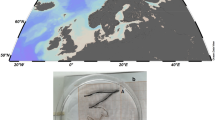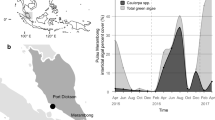Abstract
During a broad study of invertebrate colonization in marginal fluvial wetlands of the Middle Paraná River in Argentina, cyst formation was observed in two of the 26 species of aquatic oligochaetes identified from the study—Dero multibranchiata Steiren, 1892 (Tubificidae, Naidinae), andTrieminentia corderoi (Harman, 1969) (Opistocystidae). All specimens of the two species in which cyst formation was observed had been collected after drying conditions ranging from 14 to 28 days. A clitellum was not observed in any of the specimens collected. Lengths of specimens ranged from 0.88 mm to 2.84 mm inDero multibranchiata and 2.25 mm to 2.40 mm inTrieminentia corderoi. The development of protective cysts byDero multibranchiata andTrieminentia corderoi, and perhaps many other species of aquatic oligochaetes, appears to be an adaptive strategy enabling them to survive drought in temporary wetlands, recolonize freshwater habitats upon inundation, and disperse both laterally and downstream with rising water levels in wetlands and streams.
Similar content being viewed by others
Literature Cited
Adis, J. 1981. Comparative ecological studies of the terrestrial arthropod fauna in Central Amazonian inundation forest. Amazoniana 7:87–173.
Adis, J. 1984. Seasonal-igapó forest of Central Amazonian blackwater rivers and their terrestrial arthropod fauna. p. 245–268.In H. Sioli (ed.) The Amazon. Limnology and Landscape Ecology of a Mighty Tropical River and its Basin. Junk Publishers, Dordrecht, The Netherlands.
Adis, J. 1992. How to survive six months in a flooded soil: strategies in Chilopoda and Symphyla from Central Amazonian floodplains.In J. Adis and S. Tanaka (eds.) Symposium on life-history traits in tropical invertebrates (INTECOL, Yokohama, Japan 1990). Studies on Neotropical Fauna and Environments 27:117–129.
Adis, J. and G. Righi. 1989. Mass migration and life cycle adaptation a survival strategy of terrestrial earthworms in central Amazonian inundation forest. Amazoniana 11:23–30.
Anlauf, A. 1990. Cyst formation ofTubifex tubifex (Müller)—an adaptation to survive food deficiency and drought. Hydrobiologia 190:79–82.
Brinkhurst, R. O. and B. G. M. Jamieson. 1971. Aquatic Oligochaeta of the World. University of Toronto Press, Toronto, Ontario, Canada.
Brinkhurst, R. O. and M. Marchese. 1987. A contribution to the taxonomy of the aquatic Oligochaeta (Haplotaxidae, Phreodrilidae, Tubificidae) of South America. Canadian Journal of Zoology 65:3154–3162.
Brinkhurst, R. O. and M. Marchese. 1992. Guía para la idetificación de Oligoquetos acuáticos continentales de Sud y Centroamérica, second edition. Asociación de Ciencias Naturales del Litoral, Colección CLIMAX 6, Santa Fe, Argentina.
Brunke, A. C. and T. Gosner. 1999. Hyporheic invertebrates-the clinal nature of interstitial communities structured by hydrological exchange and environmental gradients. Journal of the North American Bentholological Society 18:344–362.
Casey, H. and M. Ladle. 1976. The chemistry and biology of the South Winterbourne, Dorset, England. Freshwater Biology 6:1–12.
Cernosvitov, L. 1927. Die Selbstbefruchtung bei den oligochaeten. Biologisches Zentralblatt 47:587–595.
Clinton, S. M., N. B. Grimm, and S. G. Fisher. 1996. Response of a hyporheic invertebrate assemblage to drying disturbance in a desert streams. Journal of the North American Benthological Society 15:700–712.
Cook, D. 1969. Observation on the life history and ecology of some Lumbriculidae (Annelida, Oligochaeta). Hydrobiologia 34:561–574.
del Rosario, R. B. and V. H. Resh. 2000. Invertebrates in intermittent and perennial streams: in the hyporheic zone. A refuge from drying? Journal of the North American Bentholological Society 9:680–696.
Di Persia, D. H. 1980. The Aquatic Oligochaeta of Argentina: current status of knowledge. p. 79–113.In R. O. Brinkhurst and D. G. Cook (eds.) Aquatic Oligochaete Biology. Plenum Press, New York, USA.
Erséus, C. and M. Källersjö. 2004. 18S rDNA phylogeny of Clitellata (Annelida). Zoologica Scripta 33:187–196.
Harman, W. J. and M. S. Loden. 1978. A re-evaluation of the Opistocystidae (Oligochaeta) with descriptions of two genera. Proceedings Biological Society of Washington 91:453–462.
Hrabê, S. 1929.Lamprodilus mrazeki, eine neue Lumbriculiden-Art (Oligochaeta) aus Bohmen. Zoologische Jahrbücher, Abteilung Systematik 57:197–214.
Irmler, U. 1979. Considerations on structure and function of the Central Amazonian inundation forest ecosystems with particular emphasis on selected soil animals. Oecologia 43:1–18.
Irmler, U. 1989. Population-ecology and migration ofDero multibranchiata STIEREN, 1892 (Naididae, Oligochaeta) in central Amazon inundation forest. Amazoniana 9:31–52.
Junk, W. J. 1997. Structure and function of the large central Amazonian river floodplains: synthesis and discussion. p. 455–520.In W. J. Junk (ed.) The Central Amazon Floodplain, Ecology of a Pulsing System. Springer, Berlin, Germany.
Junk, W. J., B. P. Bayley, and E. R. Sparks. 1989. The flood pulse concept in river-floodplains systems. Canadian Special Publications Fisheries Aquatic Science 106:110–127.
Junk, W. J. and G. E. Weber. 1996. Amazonians foodplains: a limnological perspective. Verhandlungen. Internationale Vereinigung für Theoretische und Angewandte Limnologie 26:149–157.
Kaster, J. L. and J. H. Bushnell. 1981a. Cyst formation byTubifex tubifex (Tubificidae). Transactions of the American Microscopical Society 100:34–41.
Kaster, J. L. and J. H. Bushnell. 1981b. Occurrence of tests and their possible significance in the worm,Tubifex tubifex (Oligochaeta). Southwestern Naturalist 26:307–310.
Ladle, M. and J. A. B. Bass. 1981. The ecology of a small chalk stream and its responses to drying during drought condition. Archiv für Hydrobiologie 90:448–466.
Marchese, M. 1987. The ecology of some benthic Oligochaeta from the Paraná River. Hydrobiologia 155:209–214.
Marchese, M. 1995. Annelida Oligochaeta. p. 709–731.In E. Lopretto and G. Tell (eds.) Ecosistemas de Aguas Contmentales. Metodologias para su Estudio. Tomo II. Ediciones Sur, La Plata, Argentina.
Marchese, M., and I. Ezcurra de Drago. 1992. Benthos of the lotic environments in the Middle Paraná River system. Transverse zonation. Hydrobiologia 237:1–14.
Marchese, M., I. Ezcurra de Drago, and E. Drago. 2002. Benthic macroinvertebrates and physical habitat relationships in the Paraná River-floodplain system. p. 111–131.In M. Mc Clain (ed.) The Ecohydrology of Southamerican Rivers and Wetlands. Cap. VIII. International Association of Hydrological Sciences. Special publications no. 6.
Marchese, M. and A. Paggi. 2004. Diversidad de Oligochaeta (Annelida) y Chironomidae (Diptera) del litoral fluvial argentino. p. 217–224.In F. A. Aceñolaza (ed.) Temas de la Biodiversidad del Litoral Fluvial Argentino. INSUGEO. Miscelánea 12. Ediciones Magna, Tucumán, Argentina.
Marmonier, P., M. J. Dole-Olivier, and M. Creuzé, Des Chãtelliers. 1992. Spatial distribution of interstitial assemblages in the flood-plain of the Rhône River. Regulated Rivers 7:75–82.
Merha, H. R. 1920. On the sexual phase in certain Indian Naididae. Proceedings of Zoological Society of London 31:457–465.
Mitsch, W. J. 1996. Managing the world's wetlands—Preserving and enhancing their ecological functions. Verhandlungen. Internationale, Vereinigung für Theoretische und Angewandte Limnologie 26:139–147.
Montanholi-Martins, M. C. and A. M. Takeda. 1999. Communities of benthic oligochaetes in relation to sediment structure in the upper Paraná River, Brazil. Studies on Neotropical Fauna and Environments 34:52–58.
Neiff, J. J. 1990. Ideas para la interpretación ecológica del Paraná. Interciencia 15:424–441.
Neiff, J. J. 1996. Large rivers of South America: toward the new approach. Verhandlungen Internationale Vereinigung Limnologie 26:167–180.
Neiff, J. J., M. H. Iriondo, and R. Carignan. 1994: Large tropical South American wetlands: an overview. p.156–165.In G. L. Link and R. J. Naiman (eds.) The Ecology and Management of Aquatic-Terrestrial Ecotones, Washington, DC, USA.
Reiss, F. 1977. Qualitative and quantitative investigations on the macrobenthic fauna of Central Amazon lakes. I. Lago Tupé, a black water lake on the lower Rio Negro. Amazoniana 6:203–235.
Righi, G. and M. E. Varela. 1983.Narapa bonettoi, gen. nov., sp. nov. (Oligochaeta, Narapidae, Fam. nov.) de agua doce da Argentina. Revista de la Asociación de Ciencias Naturales del Litoral 14:7–15.
Schellemberg, E. T., U. Hartmann, R. Zah, and E. I. Meyer. 2001. Response of epibenthic and hyporheic invertebrates to steams drying in a prealpine river. Verhandlungen. Internationale Vereinigung für Theoretische und Angewandte Limnologie 27:3733–3737.
Semernoi, V. P. 1971. Overwintering of aquatic oligochaeta in frozen ground. Biologiya Vnutrennykh Vod 9:29–32.
Stanford, J. A. and J. V. Ward. 1993. An ecosystem perspective of alluvial rivers: connectivity and the hyporheic corridor. Journal of the North American Benthological Society 12:48–60.
Takeda, A. M. 1999. Oligochaete community of alluvial upper Paraná River, Brazil: spatial and temporal distribution (1987–1988). Hydrobiologia 412:35–42.
Varela, M. E. 1984.Bratislavia unidentata (Oligochaeta, Naididae) en la provincia de Corrientes, Argentina. Historia Natural 4:2–5.
Varela, M. E. 1990. Notas taxonómicas y ecológicas sobre algunos oligoquetos dulceacuícolas del nordeste argentino. I. Naididae. Studies on Neotropical Fauna and Environments 25:223–233.
Wiggins, G. B., R. J. Mackay, and I. M. Smith. 1980. Evolutionary and ecological strategies of animals in annual temporary pools. Archiv für Hydrobiologie/Supplement 58:97–206.
Williams, D. D. and H. B. Hynes. 1976. The ecology of temporary streams. I. The faunas of two Canadians streams. Internationale Revue der Gesamten Hydrobiologie 61:761–787.
Author information
Authors and Affiliations
Rights and permissions
About this article
Cite this article
Montalto, L., Marchese, M. Cyst formation in tubificidae (Naidinae) and opistocystidae (Annelida, Oligochaeta) as an adaptive strategy for drought tolerance in fluvial wetlands of the Paraná River, Argentina. Wetlands 25, 488–494 (2005). https://doi.org/10.1672/23
Received:
Revised:
Accepted:
Issue Date:
DOI: https://doi.org/10.1672/23




